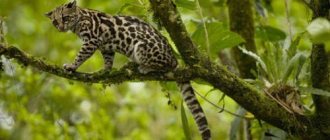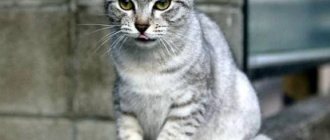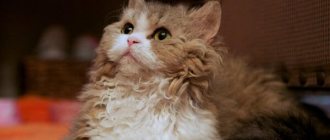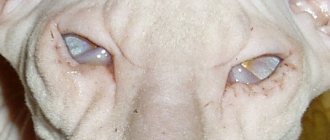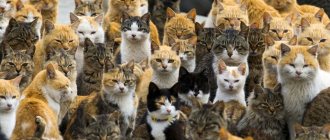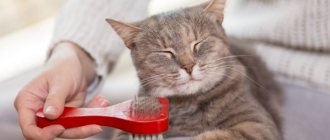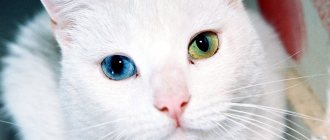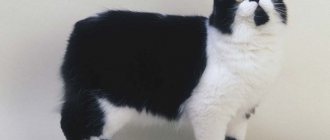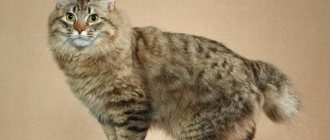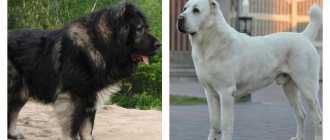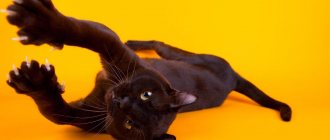Origin story
The breed was developed in Russia and entered into the register with its own standards in 1996. The first Peterbald kittens were received in 1994. For this purpose, an experimental mating was carried out between the Don Sphynx named Afinogen Myth and the world champion Oriental cat named Radma von Jaegerhof. A new breed was created by felinologist Olga Mironova with the assistance of the owner of the Don Sphynx, Tatyana Komarova. Based on the results of two matings, 4 kittens of a new breed were obtained. These kittens were given names: Sissy from Murino, Muscat from Murino, Nocturne from Murino and Mandarin from Murino. These first Peterbalds became the basis of their breed.
What does the Abyssinian cat breed look like, as well as its colors, character and behavior
In 1996, the Selective Felinological Federation (SFF) recognized the St. Petersburg Sphynx as a breed and officially established its standards, and from that moment the history of new cats begins to count. A year later, the breed was approved by TICA and assigned the PD attribute to the cats. Since 2003, these Sphinxes have been recognized by the WCF, giving them the abbreviation PBD.
Today, the development of Peterbalds is in the direction of the Siamese type and Oriental extreme. Recently, work has been carried out, aimed primarily at other external characteristics, and not at hairlessness. For this reason, now it does not matter to breeders how much hair is present on the body of the St. Petersburg Sphynx and does not affect its value both in terms of breeding and monetary value.
Nutrition and health
As a rule, the health of any animal depends on its nutrition. This directly applies to Peterbald. The lack of hair increases energy costs for heat exchange, so the Sphynx needs increased nutrition.
The Peterbald's diet should be balanced and include essential minerals and vitamins. A sign of poor nutrition will be a significant increase in the secretion of brown substance by the skin. In such a situation, you need to immediately change your pet’s menu.
According to veterinarians, Peterbalds do not have significant hereditary diseases. They are plagued by problems that are common to all hairless cats. These are colds. Sphinxes do not tolerate drafts or hypothermia. Overheating is also harmful for them.
Characteristic
| Index | Rating on a five-point scale |
| Activity | 5 |
| Affectionateness | 4 |
| Shedding | 1 |
| Need for care | 1 |
| Sociability | 4 |
| Health | 4 |
| Playfulness | 5 |
| Friendly to people and animals | 5 |
| Intellectual abilities | 4 |
- The name of the breed translated into Russian will sound like “Bald Peter”. Fans of these sphinxes prefer to call them Petriks.
- Representatives of the breed put tactile contact with the owner first, not mental connections.
- In bald Petriks, the skin constantly secretes a special secretion in large quantities, and it requires regular special care. Without it, the cat will develop health problems such as dermatitis and dermatoses.
- Hairless Peterbalds are also called Rubbers for the special elasticity and slight stickiness of their skin.
- The temperature of hairless cats is significantly higher than that of furred cats. This is noticeable even to the touch.
- Peterbalds are one of the most talkative cats among the Sphynx cats. Their voice is quite loud, with demanding intonations. They are not inclined to purr, even when they are completely relaxed.
- The breed is not suitable for allergy sufferers, since, although it does not have hair, the allergen that causes unpleasant symptoms in people is contained in cat saliva and is present in Peterbalds in no less quantity than in any other cats.
- Naked Petrikov's appetite is increased due to the peculiarities of thermoregulation. This is characteristic of all Sphinxes, and therefore they should be fed more than representatives of other breeds.
- Pets are distinguished by strong jumping ability, but at the same time combined with innate grace. Thanks to this, they almost never cause damage to the owner’s property.
- Hairless cats love warmth, and therefore, exposure to the sun. However, owners must remember that for their pets being under direct rays is dangerous. Diffused sunlight will only benefit the cat.
Character and behavior
Remember the talking bird from the fairy tale about the girl traveler Alice? So: the Peterbald is also a talker, and also affectionate and a lover of hugging and sitting in arms. Friendliness is in their blood, and they treat both people and animals equally well. Their hunting instinct is almost undeveloped, so small rodents are completely safe. However, they choose one single leader among all family members and follow him.
Peterbalds are immensely loving. Rubbing their heads on the knees of household members, climbing on shoulders, lying down at the foot of the bed - they will do all this around the clock. They adore children, especially small ones, they will play with them with pleasure and will never allow themselves to scratch or bite a baby.
Representatives of this breed are absolutely unforgiving. Even if you have offended the cat in some way, he will not dirty your shoes, tear the curtains or attack your feet from around the corner. Having quickly forgotten about the unpleasant, the animal will very soon come up again for a new portion of affection.
They respond well to training: they can fetch their toys, come when called, go to their place or to the bowl. Speaking of toys: Peterbalds love everything that rustles and rings.
If you like silence, Peterbald is not for you. These cats make many different sounds and demand the same from their owner. Extremely inquisitive. Any extraneous sound makes them wary and go for a check. And closed doors, pushed-in drawers, bags, boxes and other secluded corners for a Peterbald are like a red rag for a bull. Until the cat examines their contents, he will not calm down, so do not lead him into temptation.
What breed of cat likes to swim?
BurmaSphinxes
Loneliness is unbearable for them. If the owner is not at home for too long, the cat will greet him with a dissatisfied meow, but if this situation repeats more and more often, he may get sick.
Curiosity often plays a cruel joke on Peterbalds: cats drop something heavy on themselves, cut themselves with fragments, receive an electric shock, or fall out of windows. Therefore, secure all heavy objects, remove easily breakable dishes, hide wires and install special protective nets on windows.
Description of the breed
Breed standards are strictly established. If a particular individual deviates from them, experts decide whether it should be completely excluded from breeding or whether the defect will simply lower the scores.
If you are getting a cat just for yourself and do not plan to participate in exhibitions, then you can purchase a culling kitten according to external standards. His character will be the same as the breed envisages.
Dark variety
Dimensions and parameters
Peterbald cats are not large cats. As adults, they gain weight from 3 to 5 kg. Some particularly large cats can weigh up to 7 kg, but in this case the weight is considered normal only when the cat is not obese.
The height at the withers ranges from 25 to 30 cm. Outwardly, males look much larger and more powerful than females, although in terms of height and weight they are not much ahead of them.
A healthy representative of the breed has a body temperature of up to 39 degrees, and this is the norm. For hairy cats, this indicator is already increased. This feature of hairless cats poses a certain danger for them, since in case of illness, even a slight rise in temperature by 0.5-1 degrees immediately seriously affects the functioning of the internal organs.
If the kitten follows the line of the Don Sphynx, then as an adult it will be larger and more massive than expected from Peterbald. In some cases, such a deviation from the standard, if it is very significant, leads to complete disqualification.
How long do they live?
With proper care, Sphynx cats can live up to 13-15 years. Castrated cats and sterilized cats, if the owner provides them with prophylaxis against urolithiasis, can live 2 years longer than non-castrated cats.
Light color variety
Exhibition standards
Unlike their ancestors, the Don Sphynxes, the Petersburg Sphynxes are more graceful and compact. They are also characterized by special grace and significantly less wrinkled skin.
The cat's head is wedge-shaped, with a flattened forehead and a slightly convex profile. The skull has a pronounced expansion from the nose to the ears. The muzzle is elongated. The ears are large with a wide base.
The eyes have a beautiful almond-shaped cut, with an oblique oriental position. Cats with the point color are allowed a bright blue iris, while others have only green. The whiskers (vibrissae) are either completely absent or significantly shortened and have a broken-twisted shape.
The body of the St. Petersburg Sphynx is elongated, muscular, and has an elegant silhouette. The neck is distinguished by its grace, it is elongated, with clearly visible muscles. The chest is slightly smaller in width compared to the hips. The tail is whip-shaped, with a pointed end, thin and long. The paws are thin and high, always perfectly straight. The foot has a regular oval shape, the fingers are flexible, called monkey-like.
The cat's skin should be soft. It freely covers the body, with the formation of pronounced folds, although not as numerous as those of the Don Sphynx. In the classic version, the Peterbald is hairless, but the presence of short or sparse hair is also acceptable.
Hairless individuals require special skin care. On their own, these cats cannot provide her with the necessary health condition.
Standards
The appearance of Peterbalds is more refined and graceful than that of Sphynxes. The latter weigh 5-7 kg, while Peterbalds weigh a maximum of 5.
| Standard | Description |
| Head | Wedge-shaped, with a long and narrow muzzle. The profile is slightly convex, the forehead is flat. |
| Nose | Straight, long. |
| Eyes | Set obliquely, almond-shaped. The color of the iris is most often green, but blue is also allowed for the point color. They are spaced widely (according to the standard, one more eye can fit between them). |
| Body | Muscular and long, the silhouette is graceful. Same neck. The chest is narrower than the hips. |
| Paws | Long and thin, straight, lean. The front ones are slightly shorter than the rear ones. The pads are oval, elastic, the fingers are flexible (“monkey”). |
| Tail | Long and thin, the tip is pointed, whip-like. |
| Vibrissae | Broken-crimped or completely absent. |
| Ears | Large and tall, set wide apart, protruding beyond the cheek line. The tips are pointed. |
| Leather | Soft, forms numerous folds. There are fewer folds on the body than on the head. |
| Wool | Most often it is completely absent. On some individuals it grows very sparsely and short. |
The following types of Peterbalds are distinguished:
- Hairless cats (“gum cat”, “gummi”, classic type). You won’t find a single hair on their bodies, and their skin feels like thin rubber and is covered with a thin layer of natural brown lubricant.
- Flock. There is fur, but it is very short - up to 2 mm. Silky and pleasant to the touch.
- Velor. The coat is short or semi-long. It often disappears as the animal grows, leaving only furry “socks” at the bottom of the paws.
- Brush point. The body is covered with hair, as is the tail, but over time the body becomes bald, but the tail, paws and muzzle do not.
Peterbalds also have intermediate species (velor point, flock point, etc.), however, as the animal matures, it can change significantly in appearance. This is a significant problem, because it is impossible to guess what your pet will look like in six months or a year.
The disadvantages of the breed are: round and heavy body; crooked paws; underdeveloped chin; significant defects of the muzzle and skull; bend of the back of the nose.
If a Peterbald has strabismus or tail defects, or if the cat is aggressive, it is not allowed to compete.
In the photo there are kittens of the Peterbald breed
Types of Sphinxes
The St. Petersburg Sphynx breed has six varieties, each of which has its own characteristics. One of them relates to breeding marriage, but in some cases it is also subject to breeding. Its price is lower, since these individuals do not have the hairless gene, which they should have received from the Don Sphynx.
Bald
Hairless or Gum Cat or Gummi. These cats have no fur at all. The leather is more like soft, delicate rubber. The skin discharge is very strong, as a result of which a brown coating appears on the body, which lies in a thin layer.
Flock
Individuals do not have mustaches or eyebrows, but their body is covered with short hair, the length of which does not exceed 2 mm. It is located on the body.
Velours
The hair of kittens of this variety is semi-long or short, which, as the pet grows older, can completely disappear or remain as islands of pubescence on the paws. The coat of these cats is denser than that of the flock variety.
Brush point
Cats with an original coat distribution. On the body it is completely absent or very short, like in flock representatives, but on the muzzle, tail and paws it is thick and hard.
Brush
The cat's fur is soft or hard curly. Pubescence can be either complete or partial, all this is allowed by the breed standard. Growing up, such a pet may lose hair on its neck and back, but it will never become completely naked.
Straight-haired variety
Straight-haired variety
This is a variety lacking the baldness gene. As a result, the hair of its representative is the same as that of hairy cats, and the body type is as close as possible to the oriental breed.
In addition to the main varieties, breeders also distinguish intermediate ones, such as flock point and velor point. As they grow older, they can change into others. Because of this feature, choosing a kitten can be difficult, since it turns out to be impossible even for an experienced breeder to understand exactly what the pet will end up like.
The breed is young and kittens should only be purchased from official breeders, as otherwise there is a high risk of getting, at best, a crossbreed, and at worst, a mongrel kitten with a shaved head.
Colors of St. Petersburg Sphynxes
Peterbalds can be of completely different colors, although cream, chocolate, and lilac shades are most valued. Many cat lovers prefer color point or particolor. Cats with the same skin color are very rare; their bodies are mostly painted with simple spots. The black Peterbald looks fantastic, but this color is rare and most of them are not completely hairless, but have very short hair.
There are several main prototypes of kittens, depending on the skin:
- brush - babies have fur when they are born, but it disappears with age;
- brush point - compared to brush, the kitten has a shorter woolen coat and a fluffy tail. In an adult animal, the body becomes completely bald, but the muzzle and paws remain with fur;
- velor - a kitten is born with fur all over its body, and more on its paws and graceful tail. As the animal grows up, it sheds its fur, leaving only fur socks;
- flock - the baby has 2 mm of fur, but no eyebrows or whiskers. The skin on the kitten is soft and velvety, pleasant;
- bald - completely devoid of hair, and due to mucus secretions from the pores of the skin, it seems that the body is rubber;
- straight-haired Peterbald - a distinctive feature of this variation is the absence of the hairless gene. The kitten has short hair and normal whiskers; he does not lose them with age, but he got his character from the Sphynx.
In felinology, there are several more transitional types, but only breeders have learned to distinguish them with accuracy. Because it is not always possible to determine which variation a kitten has.
Cat colors
The colors of the Peterbald breed are varied - almost any color found in other cats:
- chocolate;
- lilac;
- tortoiseshell;
- beige;
- red is one of the rarest colors;
- blue is one of the rarest colors;
- black is one of the rarest colors;
- pink - applies only to naked varieties;
- white is one of the rarest colors.
The breed is characterized by color-point suits and oriental color types. In the case of points, these may be tabby, lilac, blue, seal, tortie, cream, red and chocolate. If the cat has an oriental color type, then these are all colors related to point, but monochromatic, and in this case tortoiseshell color is also added.
Kittens
Sphynx births are easy. Cats are caring mothers, and, remarkably, cats also participate in raising their offspring. They watch the cubs, lick them, and play. Kittens usually move to a new home at the age of three months.
The St. Petersburg Sphynx is a relatively new breed, but it is rapidly gaining popularity and receiving recognition from felinological organizations. The purpose of breeding is not only to create attractive external qualities, but also to preserve the wonderful intelligence and character of the Peterbald.
Disqualifying faults
A number of breed defects result in a cat being disqualified from breeding. Such deficiencies include underbite of more than 2 mm and entropion of the eyelids. Other defects simply reduce the show score. Such shortcomings include the following deviations from standards:
- small ears;
- low set ears;
- slightly weak body;
- shortening of the body;
- undershot less than 2 mm;
- round eye shape;
- short head;
- round head shape;
- narrow muzzle;
- short tail;
- tail curled up.
Kittens that differ from the breed standard are sold cheaper. Because of this, they are in particular demand, since when getting a cat with which it is not planned to participate in exhibitions, the future owner, as a rule, tries not to overpay.
If a breeder offers a kitten with a pronounced defect and claims that with age the defect will go away and the pet will perfectly meet the standard, then you should not believe this - this does not happen.
Features of choosing a Peterbald kitten
It is best to purchase not only a Peterbald, but any purebred kitten in a nursery - only in this case can you count on the animal being purebred and healthy. You can find a suitable nursery and find out about its reputation via the Internet.
Having chosen a nursery, you need to observe the kitten in its familiar environment. This way you can visually assess the physical condition of the animal and select a pet of a suitable temperament. A healthy cub should not cough or sneeze or itch. You also need to make sure that your eyes and ears are clean and that your gums are not inflamed.
The skin should be soft and pleasant to the touch - without dry areas or red spots. There should be no hernias on the tummy, and no swelling around the nipples. A healthy, small Peterbald should look like a bun - its tummy should be round and full. He should be playful and active, easy to make contact with.
No competent breeder will give away a kitten before three months of age. It is by this time that the animal acquires all the necessary skills and is ready for independent life.
The purchase of a pet must be documented in a sales contract. Other mandatory documents that the breeder must submit along with the animal are a birth certificate, pedigree and veterinary passport.
It is a mistaken belief that hairless cats do not cause allergies. The protein that causes the undesirable reaction is found not only in the animal’s fur, but also in the animal’s saliva and urine. Peterbalds and other sphinxes can only be called less allergenic representatives of cats.
Beautiful photos
Exhibition copy
Cute kitty
Amazing Grace
Exceptionally smart look
Young Peterbald
Nutrition
Peterbalds are voracious creatures. They need to be fed with high-quality balanced feed or natural products, in a certain quantity, with strict adherence to the balance of nutrients. They are very fond of dairy products and porridge with milk. The breed's favorite dishes are meat and fish; adding vegetables to your pet's diet is beneficial. The calorie content of food should be increased especially in winter.
In Peterbalds, lacrimation becomes more intense when feeding. During this period, you should wipe the skin around the eyes and eyelids with a napkin.
Character
Representatives of the breed are characterized by openness and contact. These cats are not characterized by rancor, and they always clearly show their attitude towards the owner. They are quick-witted and, even if offended, soon forget the bad things. Some owners may find such companions too intrusive, but this is a property of the breed that must be taken into account at the stage of choosing which pet to get. Neva Sphynxes require a lot of affection, and if they think that they have not received it, they do not hesitate to remind themselves, demanding attention. They cannot stand loneliness, and if a pet has to wait for days for its owner, then you should either buy two kittens or abandon this breed.
Despite their affection and gentleness, Peterbalds have a strong character and can defend their desires, even if the owner is against it. This is especially true when choosing a favorite place to sleep. If the owner does not provide the pet with attention, then the cat grows up mentally unbalanced, and keeping it in an apartment causes serious difficulties. Although these Sphinxes are considered dog-like to their owner, they can adapt to a new family. Moving to another home is stressful for them, but they can cope with it if they are surrounded by love and care. Under these conditions, the cat will become attached to new people and reveal to them all the charm of its character.
Sphinxes are distinguished by their easy-going nature and quick understanding of what is happening. They accept other pets into the house without any problems and are ready to take care of them, extending their affection to four-legged animals. Peterbalds build especially tender relationships with other hairless cats or dogs. In this case, the owner will be able to observe manifestations of affection and love between his pets.
By nature, these cats are incredibly curious. Almost everything is of interest to them. The pet will not be able to calmly react to a closed door or a zipped bag. He definitely needs to know what's what. The special flexibility of the fingers allows Petriks to easily open locks and fasteners. Taking this into account, the owner should not try to hide something from his pet, but rather, in his presence, let him look at what interests him.
The behavior of a cat and a cat differs, but not significantly. Females are calmer and more reasonable; it is easier to negotiate with them if necessary. They also need even more affection, but, thanks to their natural instincts, they are distinguished by unsurpassed tenderness in their relationships with their owners and pets. The cat is more independent and stubborn. Also, due to his great physical strength, he is able to more actively penetrate into places that interest him, and especially likes to open doors and climb into cabinets.
Characteristics of Peterbalds
The most important thing that Peterbald cats require is around-the-clock attention. They are terribly sociable and talkative. St. Petersburg sphinxes have a hard time experiencing loneliness, so they are ready to follow a person’s heels both day and night. At the same time, they meow loudly, and their voice is loud and harsh.
If such a bald miracle lives at home, then the owner will hardly be able to be alone with himself. Therefore, those who decide to get a chatty cat are advised to think carefully about their readiness for continuous contact with the pet. What should a person do who, despite being busy, wants to be friends with a cat? There are two options: either choose a representative of a different breed, or get another pet.
The Peterbald Sphynx is very active and playful. If you take him out for a walk wearing a collar, there will almost certainly be passers-by who will mistake him for a dog. A cat of this breed does not sit still; the world around him completely captivates this inquisitive person. He is constantly sniffing, exploring, trying something.
In addition, St. Petersburg felines are distinguished by their natural ingenuity and intelligence. It will not be difficult for the owner to teach his pet commands. For example, the St. Petersburg Sphynx may begin to bring small thrown objects.
These bald fidgets are crazy about small soft toys and ringing and rattling objects, which they fiddle with for hours. However, they can hardly be called serious hunters. Therefore, if the family already has small pets (birds, fish, hamsters, etc.), you don’t have to worry about their fate.
Peterbalds usually friendly towards all living creatures, without exception. They have a highly developed maternal instinct, for this reason Sphynxes are most likely to take care of weaker animals. St. Petersburg cats are also patient with children, but, in extreme cases, excessive importunity can be stopped with a decisive wave of a clawed paw.
Difference from other cats
There are breeds with which the St. Petersburg Sphynx has much in common, and with which a person who does not understand cats may confuse it. First of all, this applies to other varieties of Sphinxes.
Don Sphynx
The differences from the Don Sphinx of St. Petersburg are significant. First of all, Don cats are much larger and have a slightly sagging belly. Also, their heads are shorter than those of St. Petersburgers. The ears of Don cats are tilted forward, and the main folds of skin are concentrated on the stomach and at the base of the head. Their character is capricious, unlike the Peterbalds.
Canadian Sphynx
The Canadian Sphynxes also have some similarities with the St. Petersburg ones, but differ markedly from them in their short front legs, a tuft at the end of the tail, a wide and rather short muzzle, erect ears and a lemon-shaped eye shape. Their character is reserved, and they do not like it when their owners annoy them with their attention.
Ukrainian Levkoy
Peterbald also has some similarities with the Ukrainian Levkoy. However, these cats can be immediately distinguished from each other by their ears. The Ukrainian breed is fold-eared, but the Petrikovs cannot have this.
Bambino
It is not difficult to distinguish the Peterbald from the Sphinx Bambino, since the first breed is short-legged, like the Elf, Minskin or Dwelf.
Oriental
The similarity of the St. Petersburg Sphynx with Oriental cats, which are their ancestors, deserves special attention. In the case of hairless varieties, it is not difficult to understand their differences, since Orientals are always covered with hair. When the Peterbald is not hairless, it is more difficult to distinguish him, and in this case the main indicator of his breed will be his curly mustache.
Kohana
The main difference is that the Kohana breed has no hair follicles on the skin at all, which means there are no hairs at all. There are not even eyebrows or whiskers.
Description and photo
The Peterbald breed is considered a representative of the youngest variety of Sphynx, but this fact did not prevent these animals from quickly becoming famous among cat lovers around the world.
Did you know? There is a common misconception that sphinxes were specially bred by genetic scientists. In fact, there were mentions of these hairless animals back in antiquity, as well as in the era of the ancient Aztecs. In ancient Egypt, hairless cats were considered in some way magical talismans that were endowed with strong magical powers.
Appearance
The appearance of the St. Petersburg cat attracts everyone's attention with its elegant, thin, but quite strong body with an original, changing coat texture (which in some cases is completely absent).
To get acquainted with these animals in advance, you should refer to the detailed characteristics of the breed:
- Country: Russia, St. Petersburg..
- Height: average, 80–95 cm from nose to tip of tail.
- Weight: males 4–5 kg, females 3–4 kg.
- Head: Wedge-shaped with an elongated muzzle and flat, high cheekbones.
- Eyes: medium size, slanted, almond-shaped. The color does not depend on the size of the coat.
- Ears: Large, pointed and wide at the base.
- Paws: long, thin and strong. The hind legs are slightly longer than the front legs.
- Tail: Flexible and strong.
- Litter: about 5 kittens.
- Color: striking in a varied palette of colors. The most highly valued are: chocolate, cream, lilac and color point.
- Coat: unique, capable of completely changing its appearance as the Sphynx grows up.
There are several types of wool:
- Suede is a short and pleasant-to-touch fur, similar in tactile sensations to peach skin.
- Brush is a wire-type wool, slightly wavy, reminiscent of a brush in texture. Length about 5 mm. Most often, by the age of 2 years it falls out completely, but with dense density it can remain completely.
- Flock - hair is present only on the paws of kittens, which also completely fall out with age. Bare skin feels very smooth and silky to the touch.
- Velor - the wool cover is sparse, from 1 to 5 mm, not visible from a long distance. It is felt mainly when stroking, and with age it almost always completely changes to flocking.
- Hairless - kittens are initially born hairless and remain so throughout their lives. At the same time, their skin is soft, very warm and slightly sticky.
Important! Sometimes a litter may produce kittens with completely straight coats that do not fall out. The hair is short, close to the body and somewhat reminiscent of the fur of a Siamese cat. Unfortunately, straight-haired representatives do not have the right to perform at exhibitions.
Many people are interested in the question of how long St. Petersburg Sphynx cats live on average, because many of the “fashionable breeds” that have been bred are often distinguished by their short life span. In this case, the owners should not worry, because with good care and careful care, a Peterbald raised in love can live from 13 to 17 years, which is quite good for cats.
When choosing a pet, you should take into account not only the spectacular exterior, but also the habits of the animal, its character, so it is important to study the characteristics of various breeds of cats - Maine Coon, Siberian, Burmese, British, Burmese, Balinese, American Curl, Persian, Ragdoll, Devon Rex , Toygers, Cornish Rex.
Character of the breed
By their nature, purebred St. Petersburg cats are suitable for absolutely any person. These are not capricious, very sociable and friendly animals that quickly find a common language not only with the whole family, but also with other pets.
It is important to know that Peterbalds are extremely talkative, so they are not suitable for families accustomed to silence in the apartment. In addition, this breed is characterized by cleanliness, curiosity and an amazing ability to get out of any, even locked, room.
Care
Hairless cats require slightly different care than hairless cats. Because of this, when getting such a pet for the first time, the owner needs to carefully study all the features that are associated with caring for it.
They enjoy swimming
Bathing
Coated Peterbalds are less demanding on hygiene than hairless ones. This is due to the fact that hairless individuals have a high secretion of sebum.
However, you should not wash your pet very often, since the fatty film on its body performs protective functions, helping to prevent dryness and irritation. It is enough to bathe the cat only in case of severe contamination.
In order to prevent your pet from looking dirty, once every 10-14 days you can wipe it with a damp baby wipe and then lubricate its skin with baby moisturizing oil.
To wash hairless cats, you must use only a special shampoo, otherwise skin problems will arise.
Eyes
Peterbald also has no problems with his eyes. Sometimes, especially in summer, when street dust flies in through an open window, dark dirt begins to accumulate in the corners of the eyes. In this case, it is necessary to periodically clean the cat’s eyes with a cotton pad moistened with a suitable liquid.
Cleaning the ears
Cleaning the ears is mandatory, since representatives of the breed secrete a large amount of secretion from the sebaceous glands. Because of this, once a week the pet’s ears must be cleaned with a cotton swab, which is soaked in a special ear lotion purchased at a veterinary pharmacy. This procedure should not be carried out more often, as if you overdo it, skin irritation will occur.
The space between the toes and the base of the tail should be cleaned weekly of accumulations of fat. If you don't treat your paws, there will be problems with movement. By leaving the base of the tail untreated, the owner risks getting problems with the pet’s health, as it may develop overgrown wen under the skin. The skin is wiped with special veterinary wipes for caring for cats. If for some reason they are not there, then you can replace the napkin with a cotton pad moistened with chlorhexidine. However, you should not use such a cleanser as the main one, but you should still use special wipes.
The owner, in order to prevent the development of skin problems in the pet, should wipe the perineal and anal area with a damp cloth intended for the care of infants after each cat's trip to the litter tray.
The tray should always be washed clean with special cleaning products, filled with the usual filler and be in the same place familiar to the pet.
If you don't like doing the daily, unpleasant chore, you can try to retrain your pet to go to the toilet on the toilet. How to do this, read the special article.
Teeth
Like the ears, it is necessary to periodically, preferably 2-3 times a week, brush your cat’s teeth with a special brush and special ointment. It's not difficult, it's just a matter of habit.
Claws
Sometimes, not often, it is necessary to trim your cat's claws. The pet store sells a lot of tools for this procedure and you shouldn’t have any problems. At the same time, it is better to buy a high-quality scratching post and then the claws will grind down naturally.
Cloth
Clothes for Peterbald are necessary when the apartment is cool (temperature 22 degrees and below), and also if you plan to take him for walks. For a cat, you should choose indoor sweaters made of cotton, or woolen ones with a soft cotton lining. For walks, buy overalls and be sure to wear shoes. All seams of things must be flat, not rubbing delicate skin. For summer walks, shoes and a light cotton sun cover are enough.
Walks are undesirable for Sphinxes, and therefore it is better not to accustom your pet to them from the very beginning.
Nose
As a rule, there are no special problems with the organs of touch in cats of this breed. If mucus appears, you will need to rinse the cat’s nose yourself. There are no particular difficulties in this procedure and, as a rule, cat owners themselves successfully cope with it.
They are very curious
Care instructions
The Peterbald owner does not need to create greenhouse conditions for his bald friend, but there are still a number of nuances.
Temperature
The apartment must maintain a certain temperature within +22-24 degrees.
When the thermometer drops, the animal may catch a cold and get sick. That is why you need to choose the right time of year for walks, or dress your cat in a special insulated overalls.
Rubdown
Hairless cats sweat, and the sweat is brown in color and can stain surrounding objects. From time to time, wipe your pet with a damp sponge or towel soaked in a special cleansing lotion. By the way: if the grease is very dark, your pet is clearly not eating properly. Adjust your diet.
Bathing
These cats are bathed at least 4 times a month, in warm water and with special cat shampoo or tar soap. Other human cleaning products cause the delicate skin of Peterbalds to become inflamed. After bathing, wrap the animal in a towel and dry it with a hairdryer or near a radiator.
Ears
The ears are cleaned every week with soft cotton swabs soaked in ear lotion.
Claws
It is enough to trim the claws once every 14 days. But if your animal actively uses a scratching post, you can do this less often.
Eyes
Peterbald kittens are often born with their eyes already open, or open them in the first few days. However, this feature develops into a problem with age: excessive lacrimation is what the owner of the animal will have to face. In this case, you will have to wash and wipe them every day.
The photo shows a Peterbald cat on a walk.
Feeding rules
If for some reason you get a very small kitten, you will have to make great efforts to feed it properly.
The nutritional rules for kittens only 1 month old are quite complex and strict; violations of the regime will certainly affect the kitten’s health later. Next, you will just need to follow the rules for feeding kittens according to age, it’s easier.
Increased appetite, associated with the peculiarities of the body's thermoregulation, leads to the fact that without proper nutrition, the pet begins to suffer from obesity. This poses a danger to his health and should not be allowed to arise. Without restrictions, you can feed your cat the right food for up to a year while it is actively growing. Further, feeding should be strictly portioned with food given at a time.
This problem is best solved with an automatic cat feeder. It will accurately measure the amount of food and dispense it exactly on time and even notify you about it on your smartphone. And if you add a special automatic drinker to the kit, then you can certainly be completely calm about the health of your pet.
These Sphinxes never refuse to eat an extra meal, so the owner will always have to put everything edible in places inaccessible to the pet. This is especially true for foods that are harmful to cats, such as chocolate, cookies and chips. If Peterbalds want to eat, they will check all the dishes in the kitchen, even remove the lids from the pots. They will also open cabinet doors if there are no locks on them. They would also check the refrigerator, but its door is too heavy for them and cannot be opened, although cats usually try to do this.
You can feed Peterbalds with ready-made super-premium diets or natural food that is prepared especially for your pet. In the second case, the diet will be the same as proper nutrition for representatives of other breeds, but with the only peculiarity that portions for St. Petersburg Sphynxes should be larger. The only difference with the diet of other cats is that Sphinxes are not given fish often and only boiled.
If you choose to sterilize your pet, then you will have to qualitatively change its feeding diet. Read more about this in a special article.
We tried to more or less briefly outline the rules of nutrition for hairless cats. If you are interested in this topic in more detail, follow this link to a special article, where the same thing is described in much more detail.
Mother cat protects her kittens
Catering
We'll still have to look for gluttons like Peterbalds. Representatives of the breed are rarely picky, but usually they happily eat everything they receive from their master’s hands. This is due to the increased metabolism of these animals: high metabolism helps maintain the required body temperature. Therefore, a hungry Peterbald will freeze.
Natural products
What should be included in a cat's diet?
- Meat products (2/3 of the daily diet): beef, turkey, chicken, rabbit. There is no need to boil the meat - just pour boiling water over the piece.
- Sea fish (once a week): hake, cod, salmon, trout.
- Eggs (2-3 times a week): whole quail eggs, from chicken eggs - only the boiled yolk.
- Offal (2 times a week): hearts, kidneys, stomachs - boiled.
- Vegetables (every day): carrots, zucchini, cucumbers, green beans, pumpkin - boiled or stewed, mixed with porridge or added to meat broth.
- Fermented milk products (every other day): kefir, natural yogurt, low-fat cottage cheese, sour cream, cream.
- Porridge (every day): oatmeal, pearl barley, buckwheat, millet, boiled in water.
- Sprouted oats or special grass: place the grass next to the bowl, and the cat will nibble on it whenever it wants.
- Vegetable oil (2-3 times a week): half a teaspoon in porridge.
Kittens 1-2 months eat 6-7 times a day, 3-4 months - 4 times, from 4 to 6 - 3 times, older than six months - 2 times, like adult animals.
It is forbidden to give cats:
- Fatty meat and river fish - they cause stomach upset and are poorly digestible;
- Milk – causes diarrhea;
- Canned food, pickles, seasonings, sauces - irritate the gastric mucosa;
- Sausages, smoked meats, lard - provoke the development of tumors, disrupt metabolism, cause gastritis and cardiovascular pathologies;
- Baked goods, pasta: lead to obesity, but do not provide any benefit;
- Sweets – disrupt heart rhythm, obesity, vascular problems;
- Onions, garlic - cause anemia;
- Fruits (except apples) – cause breathing problems, kidney pathologies;
- Bones - can scratch the stomach lining, pierce it and kill the animal.
Recommended food
Ready-made industrial feeds significantly save the owner’s time. When choosing food, choose holistic, super-premium or premium food. Dry can be combined with wet, but of the same brand: Iams, Canagan, Carnilove, Arden Grange, 1st Choice.
Below are recommended premium and holistic foods. Links with the names of the food are clickable, on them you can, within our website, read the descriptions of the food and read reviews from owners of the Peterbald cat breed.
| Holistic | Holistic | Premium |
| Applaws | Power of Nature | Flatazor |
And a few more rules:
- You cannot feed your cat both natural food and industrial food. Pick one thing.
- Food is only at a comfortable temperature, as is water.
- Do not give your pet spoiled or old food.
- Separate the sleeping area and the eating area.
- Get used to the new menu gradually. If he refuses to eat solid foods, they need to be crushed.
Mating, pregnancy and childbirth
So far the breed is not numerous and there are only a few nurseries breeding it.
When breeding, mixing Peterbalds with Bolinesian, Javanese, Siamese and Oriental breeds is allowed. Breeding with other Sphinxes is strictly prohibited. The age of cats for first mating is similar to other breeds.
In the absence of pathologies, pregnancy and childbirth in Peterbald cats proceed normally, without the intervention of a veterinarian. It is necessary to organize a nest for the pet in which she can safely give birth to kittens. The owner must monitor her throughout the entire period of birth, so that if any problem arises, immediately seek veterinary help. The most important thing is not to skimp on quality food for a pregnant and then lactating cat. All this will directly affect the health of the offspring.
If the mother cat has no or insufficient milk, a special cat milk substitute is recommended for supplementary feeding.
Diseases
Peterbalds live about 13-15 years. But there are a number of factors that negatively affect their health and life expectancy. They should be remembered.
Firstly, these are direct rays of the sun. Burns form instantly on the Peterbald's delicate skin, so take care of it.
Secondly, Peterbald skin is prone to acne and various types of irritation. The means at hand will help you cope with it, for example, a fresh decoction of chamomile. It is not uncommon for Peterbalds to injure themselves while playing. If you notice a fresh scratch, immediately treat it with hydrogen peroxide.
Peterbalds have a genetic predisposition to certain diseases.
- Gingival hyperplasia: occurs frequently and is often combined with the development of purulent conjunctivitis. Quickly becomes chronic. A complete cure is impossible, but improvement is possible.
- Congenital underdevelopment of the thymus gland or kitten “falling asleep” syndrome (caused by a gene mutation). Often causes the death of the entire litter.
- Vasculitis of the skin: inflammation of the walls of blood vessels. There are several clinical manifestations. Develops due to stress or infection. With timely treatment, complete recovery is possible.
- Curvature of the caudal spine. Other anomalies are almost always present (weakness of the sphincter, dwarfism, shortening of the lower jaw).
- Inversion of the eyelids: in this case, the edge of the eyelid or eyelashes touch the eyeball. The only way to cope with the disease is through surgery, otherwise the cat will develop conjunctivitis and keratitis.
- Microphthalmos: abnormal development of the eyes. This may be blindness, decreased visual acuity, cataracts, congenital keratitis, orbital tumors, cyst formation, and the like.
- Carp bite: the lower jaw is too short. Cats adapt to their condition, but they are not allowed to be bred.
Expert opinion
Dusheba Vera Ivanovna
In 2010, she graduated from the Moscow State Academy of Veterinary Medicine named after K.I. Scriabin with honors, specializing in veterinary medicine. I regularly attend veterinary conferences, congresses, and webinars.
You cannot “mate” two completely naked animals. Unfortunately, it has already been proven that kittens are almost always born with serious pathologies.
Health
The health of the St. Petersburg Sphynxes is quite strong, and the baldness gene did not cause serious disturbances in them. At the same time, there is no guarantee that as this breed develops, congenital hereditary defects will not arise against the background of genetic mutations, which will have a significant impact on the further formation of Peterbalds.
Today, some breeders, despite the strength of the cats they breed, believe that they still have a predisposition to lung problems. Sometimes Peterbalds have underdeveloped thymus glands and gum hyperplasia.
Cat fur care
Other health problems are no more common in them than in all other cat breeds. To keep the Sphinx healthy, he just needs to be provided with proper care and diet. You will also need to regularly visit a veterinarian to prevent the occurrence of pathologies. For young cats, once a year is enough, and for pets whose age has passed 7 years, once every 6 months.
Colors
Peterbalds repeat the colors of their ancestors: Orientals and Siamese.
Siamese
Siamese color (color-point): babies are born snow-white, but gradually begin to change color.
There are several options:
- red point (tail and ears are orange, body is light, paw pads and nose are pink, eyes are blue);
- cream point (they differ from the red point color only in saturation:
- tail and ears are pale yellow);
- chocolate point (limbs, tail, ears and nose are brown, body is light);
- seal point (similar to chocolate point, but a little lighter);
- lilac point (gray nose, gray-pink paws, tail and ears);
- blue point (gray shades of the body);
- tabby point (characterized by stripes on the paws, tail and muzzle);
- Terti-point (tortoiseshell).
Oriental
Oriental colors (distinctive feature – green tint of eyes):
- tabby (black, chocolate, blue);
- bicolor (white color combined with any other primary color);
- chocolate;
- tortoiseshell (only females can have this color);
- red (bright spots or stripes on the body that fade with age);
- cream (light red);
- blue (with a silver tint);
- black.
Expert opinion
Dusheba Vera Ivanovna
In 2010, she graduated from the Moscow State Academy of Veterinary Medicine named after K.I. Scriabin with honors, specializing in veterinary medicine. I regularly attend veterinary conferences, congresses, and webinars.
Many people think that the absence of hair automatically means that it is impossible to provoke an allergic process. And this is a big mistake. The allergy-causing protein is found in both the animal’s urine and saliva, and not just in the fur. The only plus: Peterbalds are slightly less allergenic.
Choice of kittens
- When deciding whether to purchase a St. Petersburg Sphynx or not, you need to study all the features of this breed and soberly assess whether it is possible to provide your future pet with everything necessary for a comfortable life. If you have the slightest doubt about your abilities, you should refuse to purchase such a breed.
- Unscrupulous sellers may sell a shaved Peterbald instead of a hairless kitten. This can only be avoided by buying a pet from an officially registered nursery.
- Color point kittens are completely white at birth. Their color appears only a few days after birth. Also, the final appearance of a cat is formed only by the age of 2 years, and therefore, when choosing a kitten, it is worth remembering that it can still change a lot.
- The kitten should be carefully examined for signs of developmental disorders, parasites, or injury. If the baby's keel protrudes strongly when he sits, this is a sign of subluxation of the sternum, which is considered a significant defect.
- The kitten's tail should be carefully felt. There should be no knots, creases, folds of skin or an empty leather bag at the end.
- The kitten's skin should be healthy. The presence of acne and signs of dermatoses and eczema is unacceptable on it. At the same time, the small scratches that brothers and sisters leave for the baby should not bother you when choosing.
Breeding
Peterbalds are bred by nurseries and experienced breeders. To preserve and improve the characteristics of the breed, they carefully select pairs for mating. Currently, crossing with other sphinxes is prohibited, as this will be a step back: the physique will be more powerful. Crossbreeding with Siamese, Oriental and Balinese cats is allowed.
In some nurseries, experts are trying to establish the trait of hairless cats. Others tend to note the Siamese-Oriental appearance. Experts from felinological associations believe that it is time to move on to stabilizing the breed and carry out selection without crossing with other cats.
When breeding in a nursery, kittens are activated at the age of 2 months. This check establishes compliance with the breed standard and identifies defects and diseases. As a result, the entire litter receives registration documents.
Mating
It is more comfortable for a cat to mate in its own territory. On the 2-3rd day after the start of estrus, the cat is brought to the male and left with him for 3-5 days.
The following rules are observed:
- at the first mating, the cat should be from one and a half to three years old, and the female cat should be from one to three years old, this is the optimal age of animals for producing the first offspring;
- for a cat, the first mating is permissible only after two or three heats;
- mating of a cat should not be repeated more than 2 times a year;
- one of the partners must already have sexual experience;
- both partners are healthy and vaccinated;
- the pair must be genetically similar to avoid serious illnesses in the kittens or their intrauterine death.
Care of offspring
Peterbald kittens show activity early, opening their eyes already on the 2-3rd day. Newborns are usually covered with fur. Less often they are born completely naked.
It is too early to take a kitten away from a cat at the age of 1 month. He feeds on his own and is ready to use the tray, but is still psychologically weak and, having lost his maternal immunity, will be susceptible to diseases. Breeders hand the kittens over to their new owners after receiving their first vaccinations and switching them to adult food, that is, no earlier than after 12 weeks.
The first vaccination is carried out when they are 8-12 weeks old, the second - after changing teeth, at 6-8 months. In the future, vaccination should be repeated annually in accordance with the recommendation of the veterinarian.
The first thing to do is to provide the kitten with a warm, cozy house or bed.
Attention should be paid to the prevention of rickets. The risk group includes kittens born in spring or winter, or those who were bottle-fed. If a biochemical blood test shows a lack of calcium and phosphorus, it is necessary to begin correction by drawing up a special diet.
The conditions for keeping and caring for a healthy kitten are no different from the conditions for keeping an adult cat. Outdoor games are important for kittens, which help them grow and develop both physically and psychologically.
Advantages and disadvantages
| pros | Minuses |
| Playfulness | Special care needs |
| High IQ | Obsessiveness associated with the need for constant affection |
| Lack of aggression | The need to buy clothes |
| Omnivorous | Frequent, prolonged meowing |
| Easy to learn | Irresistible curiosity that causes your pet to open bags, doors and cabinets |
| Gets along well with all family members | |
| Affectionateness |
How to feed a cat
Feeding purebred St. Petersburg cats is one of the main conditions for proper care and care, since this procedure has significant features.
Kitten
Before preparing a diet for a small Sphynx, it is necessary to take into account its high need for food, because of all other breeds, the St. Petersburg cat is considered the most “gluttonous”. This is due to the increased metabolism of these animals: thanks to this metabolism, they are able to maintain a high body temperature. The selection of the type of food should depend entirely on the baby’s food preferences and the wishes of the owner.
For convenience, you can use professional super-premium food for kittens, which already contains all the prepared and balanced substances, taking into account the growing body.
But if you decide to feed your pet natural products, you should definitely try to correctly determine the proportions of products: cottage cheese, offal, fish, cereals and lean meat, so that the little sphinx is always full, energetic and happy.
Adult
The nutrition of an adult St. Petersburg cat is fundamentally no different from the nutrition of a kitten, the only thing is that you need to increase the portion size (on the pack of veterinary dry or wet food there is a special table for calculating the amount of food taking into account the weight of your pet).
But even if you give preference to industrial food, do not forget to feed your pet with grains, dairy products (preferably lactose-free) and herbs from time to time.
Interesting Facts
- Peterbalds are among the youngest Sphinxes.
- The character of the representatives of the breed is similar to that of a dog. They constantly follow their owner and are even ready to bring their toys in their teeth to show that it’s time to have fun.
- Good-natured disposition and high intelligence allow these Sphinxes to easily get along with various pets, including even rodents, which for most other cats are only an object of hunting.
Photo of a Peterbald cat
Read here Ragamuffin cat - description of the unique breed and the pet’s character (95 photos and videos)
Help the site, share with friends 
Kitten price
It is necessary to purchase a kitten only from professional nurseries at least three months old. A veterinary passport is required. Today, the sale of the St. Petersburg Sphynx is carried out by numerous breeders from different cities of Russia.
The cost of an animal varies widely depending on the purpose of purchase. You can buy a Neva Sphynx as a pet for ten thousand rubles. The price of a pet for professional breeding or exhibition work will be significantly higher.
Photo gallery of Peterbald and some other types of sphinxes:
Price
It is best to buy a Peterbald kitten from professional breeders. This choice will allow you to purchase a healthy pet, because the breed is very whimsical.
The kitten must have a document indicating the vaccinations received, and a certificate of breed conformity.
The price of Peterbald kittens ranges from 5 to 10 thousand rubles.
Breed standards
The Peterbald Sphynx in the photo is a bright representative of the breed. Strong, long body, long neck, paws and tail. The head is elongated, with flat cheekbones and forehead. The muzzle is also elongated, narrow, the chin should be at the same level as the nose. The eyes are almond-shaped, the profile is straight. The paws are oval, mobile, with long fingers and claws. The skin is thin, with moving folds. There may also be residual fur at the base of the ears, on the face, paws and tip of the tail. The mustache is always curled (this is clearly visible in the photo of the Peterbald), and from birth - this is the main sign of belonging to the breed at birth.
Faults and defects: short or rounded head, small ears, short body or tail, underbite, broken tail, complete hairiness of the body, turning up of the eyelids.
Feeding the cat
Peterbald is a cat with accelerated metabolic processes. Therefore, he is not picky about food and has an excellent appetite.
With an industrial type of nutrition, St. Petersburg Sphynxes buy premium or super-premium products, which contain all the required vitamins and minerals.
Cats of this breed eat the following brands of food best:
- Farmina;
- Bosch;
- Gemon;
- Brit Care.
With a natural type of nutrition, the Peterbald is fed mainly with fresh, lean meat. Also included in the menu of cats of this breed:
- porridge with water;
- eggs;
- offal;
- boiled vegetables;
- sea fish;
- dairy products.
It is strictly forbidden to feed the St. Petersburg Sphynx with river fish, bones, sweets, baked goods, sausages, smoked meats and pickles. The menu of a cat of this breed should not contain fried, fatty and spicy foods, as well as leftovers from the owner’s table.
Care and maintenance
Due to their exposed skin, Peterbalds constantly get dirty and often sweat in hot weather. To protect the skin, the body secretes a protective barrier in the form of a brown wax-like coating. In normal quantities, this plaque is not dangerous - just wipe it with special wipes.
However, the animal should be bathed as often as possible - 3-4 times a month. After each bath, wipe your pet dry to prevent it from getting too cold and catching a cold.
Monitor the condition of the animal's eyes - due to the lack of eyelashes, secretions often accumulate in them, which must be removed with a cotton pad soaked in water.
Also clean your pet's ears regularly.
Peterbald is shown active games in the fresh air. The main thing is to put on overalls or a suit to protect their skin from frost or extreme heat.
Brief history of the breed
The Peterbald is a very young breed of cat. The breed is the result of targeted selection work by St. Petersburg resident Olga Mironova. Orientals and the Don sphinxes took part in its formation. The first such kittens were born in 1994 as a result of planned outcrossing.
Peterbald very quickly acquired official status and recognition from leading felinological organizations. It was registered by TICA in 1997. And 6 years later, Peterbald cats received recognition from the WCF. And although the St. Petersburg Sphynxes have official registration and standard, breeders still care about the extreme nature of their exterior.
According to professionals, the appearance of cats of this breed should be as close as possible to the Siamese-Oriental type.
